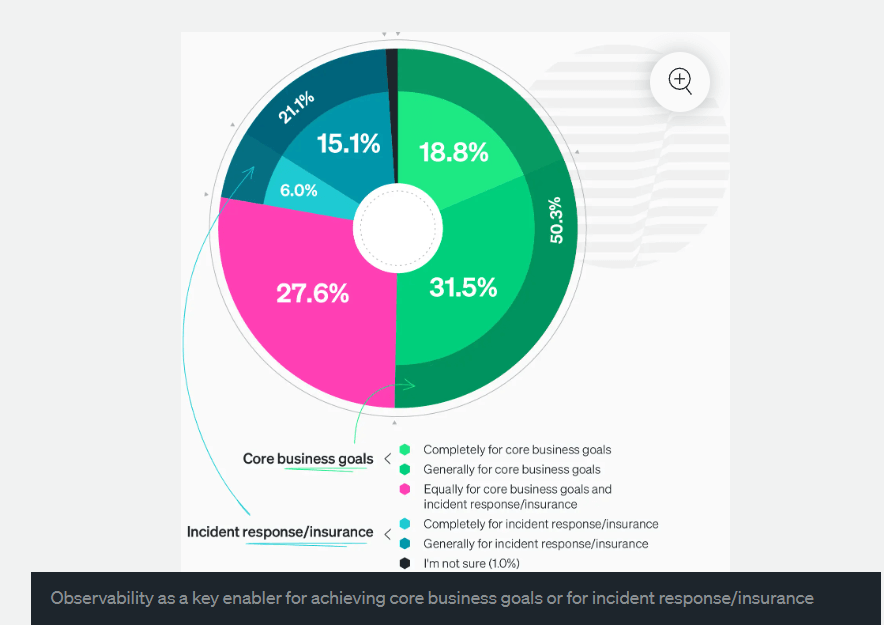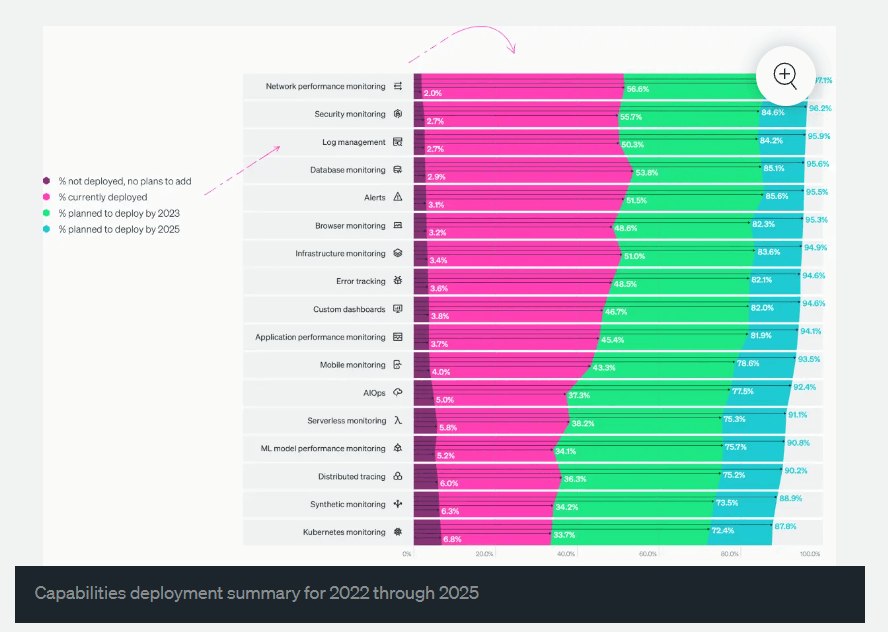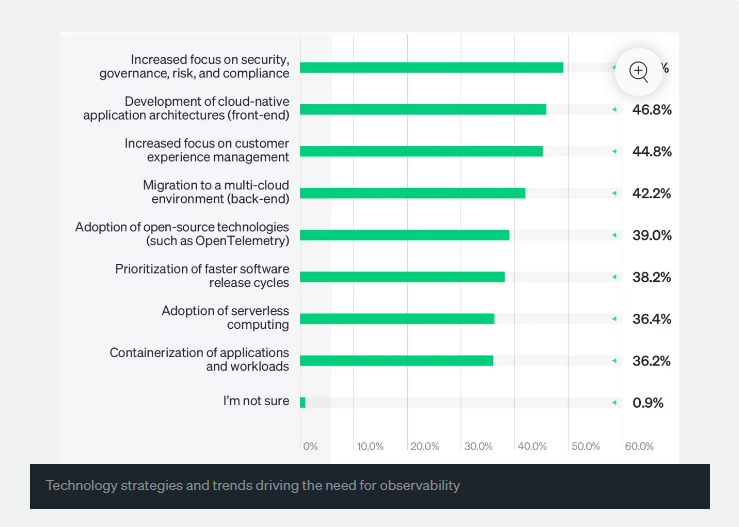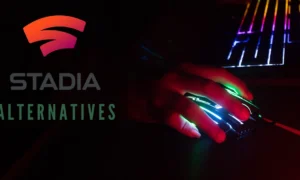In the 21st century, we live in a world of monitoring. Every industry, company, and organization measures, tracks, and records information related to all aspects of a business, including development efforts.
Observability has quickly established itself as an integral component of the enterprise’s operational and security architectures. But just how vital is observability? Is it enough to track events as they occur?

The current movement to monitor systems is shifting the industry. Observability is becoming the standard, something that developers should anticipate. A new breed of tools is emerging to power this unique monitoring style.
The space is packed with new tools, each with its twist on the familiar ‘monitoring ingredients’ of metrics, alerts, and dashboards. At the same time, we are rebalancing the performance metric mix towards observability and away from isolation.
See Also: 15 Trends in Software Development Now
What is Observability?
Observability is the process of monitoring, measuring, and analyzing the behavior and health of an application or system. It is essential for understanding how an application works and detecting issues that may arise in applications.

Additionally, it can be used to monitor and manage the health of an application or a system from a single server to a cloud deployment, along with monitoring complex systems composed of multiple components or services, such as microservices, containers, virtual machines, or physical machines.
As observability tools have evolved, companies can detect and respond to outages faster. However, there are still many challenges to overcome regarding observability.
5 Key Observability Trends for 2023
From the early days of DevOps and the creation of the DevOps Toolchain, observability has been at the center of DevOps. As we move into a post-DevOps era, observability is no longer “nice to have” but has become an essential part of a company’s operations. The evolution of observability can be seen in how companies across industries use it.

Let’s Take a Closer Look at the Top 5 Observability Trends:
1. Distributed Tracing Is the New Norm
Distributed tracing is a technique for understanding how an application performs across a distributed system. It lets you know how individual transactions flow through your systems and how they interact.
This allows you to see the entire flow of information between all components of your system to understand where there are latency issues or performance bottlenecks.
The main benefit of distributed tracing is that it lets you identify where errors occur within microservices architectures — something traditional logging methods don’t do well enough.
It is helpful because it gives you a unified picture of all the requests in your system at a given time, which can help you troubleshoot problems faster and more accurately than traditional monitoring systems that only report on one service at a time.
You May Like: Top 8 New Technology Trends
2. Observability Is Becoming More Integrated and Consistent
Observability tools have traditionally had unique APIs and interfaces, making it difficult for developers to work together.
But now, emerging standards make these tools more interoperable and reusable, which will drive down costs while improving observability across an organization.
Observability is no longer just about monitoring and alerting but also about how applications are deployed, managed, and scaled.
We’re starting to see observability become more integrated into the application stack rather than being something that sits on top of it.
With this integration comes the need for observability tools to support multiple languages, frameworks, databases, and infrastructures.
This means that tools will need new features such as cross-platform support, auto-scaling capabilities, and integration with other technologies like containers.
3. Datasets Are Getting Bigger and More Complex
As applications grow in size and complexity, more significant amounts of data will be collected from multiple sources that need to be analyzed and acted upon by teams across the organization.
This will require new ways of storing, analyzing, and presenting data to get better insights faster. The number of IoT devices is expected to grow to 29 billion devices by 2030. This means that you will need to be able to analyze more data than ever before.
Modern applications are often built on dozens or hundreds of microservices, meaning many different technologies are involved in each application.
This makes it more difficult to debug issues when they arise because the problem might be caused by one of those new technologies instead of something your team is familiar with.
To combat this problem, you’ll want observability tools that can aggregate logs from multiple sources and make them easier for developers to search through, so they can quickly pinpoint where errors occur.
Also Read: 6 Smart Cities Trends (Updates Included)
4. Self-Healing Infrastructure at Scale
The most significant trend of all is the rise of self-healing infrastructure.
It’s the idea that the system will recognize when it has been compromised, and then it will automatically take steps to correct the problem, restore itself to its normal state, and prevent further damage.
One option is instrumentation. You can instrument your application or operating system to detect when something unusual happens.
For example, if a server starts sending out requests to some strange IP address or URL unexpectedly, you know something is wrong and should investigate immediately.
Another option is anomaly detection. Instead of looking at normal behavior for each server or application, you look at how those things relate.
If one server suddenly starts sending requests to another in an unusual way, that would be suspicious activity even if all of the individual requests were legitimate on their own (e.g., because they’re all part of a single transaction).
5. Correlations Across Service Boundaries on the Rise
Operations teams are being asked to manage more and more services, which means they need to be able to correlate events across them. This can be hard when services are written in different languages or by other teams.
One way to solve this problem is through observability tools that can detect the same event across different services, even if they have different implementations.
For example, if you were using Amazon’s DynamoDB as your database but Google’s Spanner as your key-value store, you could use an observability tool that can detect key-value events in both systems and identify them as the same event.
This would allow operations teams to understand how their applications are performing without having to change how they write code at all.
See Also: Java Trends – Advantages and Disadvantages that You Should Know
Conclusion
All this makes observability more crucial than ever. And as it becomes a higher priority, our definition of observability will naturally crystallize. We’ll learn from our mistakes and improve at building systems that are essentially explainable by design.
Srushti Vachhrajani is an ambitious, passionate, and out-of-the-box thinking woman having a vast exposure in Digital Marketing. Her key focus is to serve her clients with the latest innovation in her field leading to fast and effective results. Working beyond expectations and delivering the best possible results in her professional motto. Other than work, she loves traveling, exploring new things, and spending quality time with family.





















